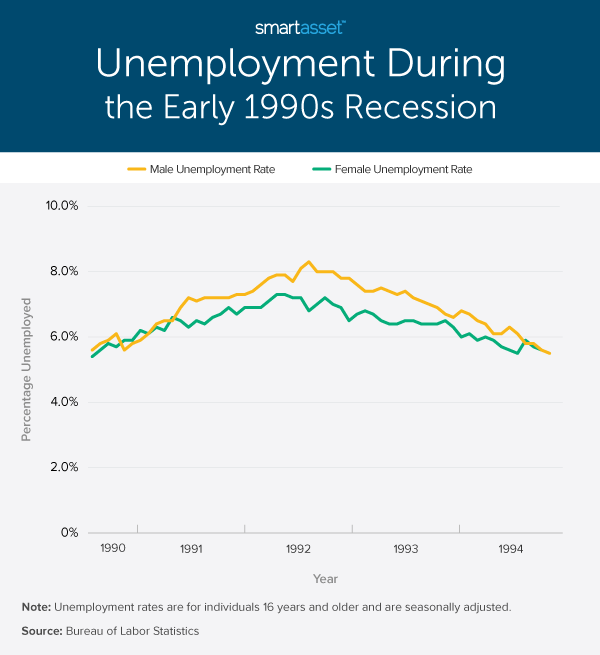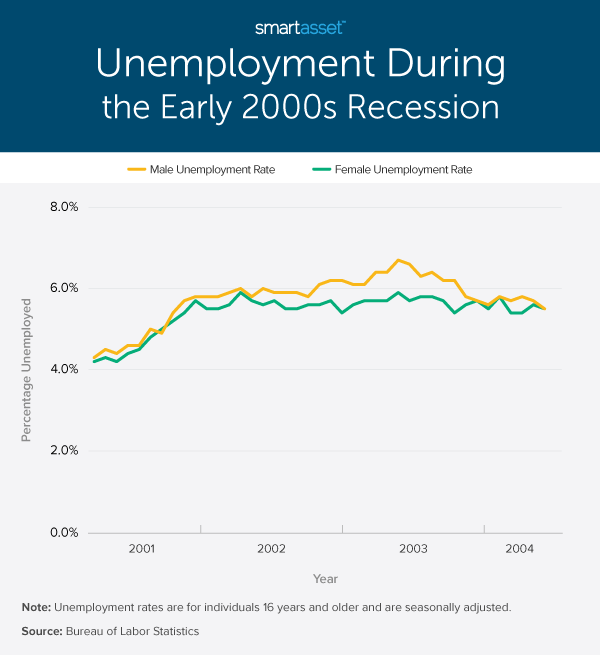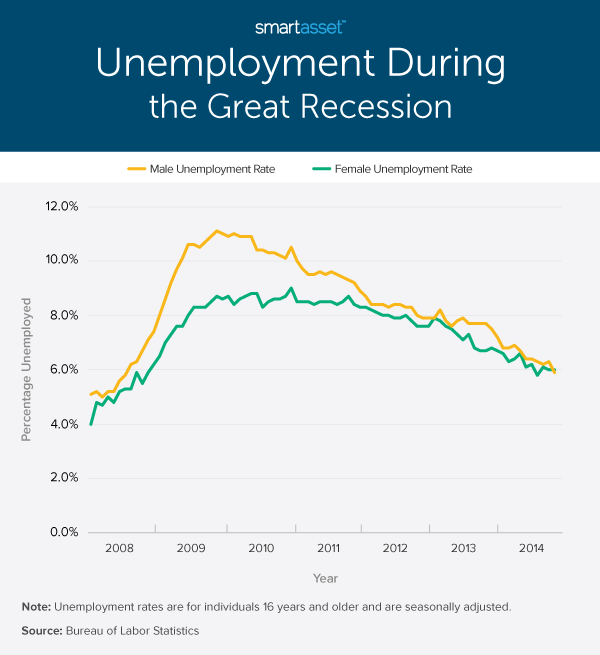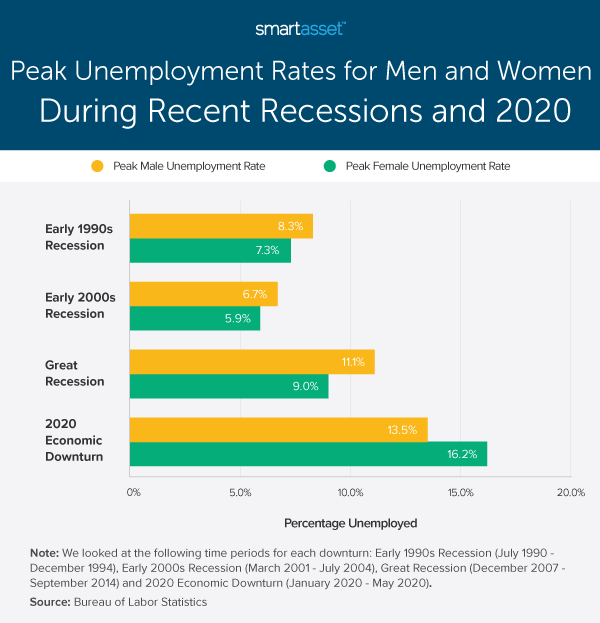The gender unemployment gap is defined as the difference between female and male unemployment rates. A “positive” gap indicates that female unemployment is higher than male unemployment while a “negative” gap indicates the opposite. Though the gender unemployment gap was positive for much of the 20th century, the gap closed as employment opportunities for women expanded in the second half, in turn allowing for more opportunities to spend and save. Since the 1980s, the gap has been virtually nonexistent, with the exception of recessions.
In this study, SmartAsset took a closer look at the gender unemployment gap during recent recessions and in 2020. Specifically, we considered male and female unemployment rates during the early 1990s recession, the early 2000s recession, the Great Recession and the coronavirus pandemic. We also explored what drives varying unemployment rates between men and women. For details on our data sources and how we put it all together to create our findings, check out the Data and Methodology section below.
Key Findings
- Peak unemployment rates were higher for men than women during past recessions. In both the early 1990s recession and early 2000s recession, the peak unemployment rate for men was about one percentage point higher than the peak unemployment rate for women. The difference was even larger during the Great Recession, when male-dominated industries, such as manufacturing and construction, were most affected. During the Great Recession, male unemployment peaked at 11.1% while female unemployment reached only as high as 9.0%.
- Thus far during the coronavirus pandemic, women have been more exposed to layoffs than men. In the past two months, the female unemployment rate was more than two percentage points higher than the male unemployment rate. The difference was largest in April, when female unemployment was at 16.2% compared to the male unemployment rate of 13.5%.
Early 1990s and 2000s Recessions
Believed to be precipitated by restrictive monetary policy, the early 1990s recession lasted from July 1990 to March 1991. Though the recession technically ended in 1991, the national unemployment rate peaked in June of the following year, at 7.8%. In fact, unemployment remained elevated through the end of 1994, only falling back to its pre-recession level – 5.5% – in December of that year.
During the early 1990s recession, male unemployment rose to higher levels than female unemployment. In July 1990, male and female unemployment were roughly the same, at 5.6% and 5.4%, respectively. However, in June 1992, male unemployment was 8.3% while female unemployment was a full percentage point lower, at 7.3%. The graph below shows male and female unemployment rates from the beginning of the recession, July 1990, through December 1994.

Like in the early 1990s recession, men experienced higher unemployment rates than women following the early 2000s recession. The early 2000s recession occurred between March and November 2001, though unemployment peaked at 6.3% in June 2003. During that month, male unemployment was 6.7% and female unemployment was 5.9%. The graph below shows unemployment rates by gender from March 2001 through July 2004.

The Great Recession and the Coronavirus Crisis in 2020
Job losses were more widespread and prolonged in the Great Recession than job losses during either of the two previous recessions. National unemployment peaked in October 2009, at 10.0% – more than two percentage points higher than peak unemployment during the two previous recessions. Moreover, unemployment stayed above 9.0% until October 2011, almost four years after the onset of the recession. Only in September 2014 did it fall below 6.0%.
Unlike both the early 1990s and 2000s recessions, where male and female unemployment rates peaked in the same months, male unemployment during the Great Recession peaked prior to female unemployment. In October 2009, male unemployment hit 11.1%, its highest rate during the Great Recession. Female unemployment had a lower high when it peaked near the end of the following year. In October 2010, 9.0% of women were unemployed.

High unemployment rates during the Great Recession pale in comparison to recent unemployment rates during the coronavirus pandemic. Between February and April of this year, the national unemployment rate spiked 11.2 percentage points from 3.5% to 14.7%. In the most recent May jobs report released by the Bureau of Labor Statistics, the national unemployment rate was 13.3% .
Though male and female unemployment rates are higher now than they have been throughout the past 30 years and spanning three recessions, more women have faced unemployment in recent months than men. In both April and May, the gender unemployment gap has exceeded two percentage points. Specifically, the female unemployment rates in April and May were 16.2% and 14.5%, respectively. By contrast, the male unemployment in April was 13.5% and in May, that figure dropped to 12.2%. The bar graph below shows the peak unemployment rates for men and women during each of the three recessions we previously discussed, along with the 2020 rates.

What Drives Varying Unemployment Rates Between Men and Women?
In a 2018 study, economists Stefania Albanesi and Aysegul Sahin found that the steady convergence in male and female labor force participation rates led to the closing of the gender unemployment gap that existed prior to the 1980s. In other words, the closer that female labor force participation rates became to male labor force participation rates, the smaller the pre-1980s gender unemployment gap became. However, since this gap in labor force participation rates remained relatively steady in the last decade of the 20th century and through the beginning of the 21st, the difference in and of itself is not a likely driver of higher male unemployment during recessions.
Rather, Albanesi and Sahin found that unequal gender distributions across industries was the primary determinant in male and female unemployment rate differences during recessions. They estimated the change in the unemployment rate for women if women had the same industry distribution as men. Assuming equal distribution by sex, increases in female unemployment rates would have been similar to male unemployment rates in the early 1990s, early 2000s and Great Recession.
Albanesi and Sahin’s theory likely holds some weight when applied to 2020. The higher increase in female unemployment rate in recent months may also be attributed to higher numbers of female workers working in the most affected industries such as accommodation & food services and healthcare & social assistance. At the end of 2019, 52.8% of accommodation & food services workers and 78.1% of healthcare & social assistance workers were women.
Job losses for women during the coronavirus pandemic may extend beyond differences in industry distribution by gender. A May 2020 paper from the National Women’s Law Center found that women were disproportionately affected even when considering the fact that they comprise higher percentages of workforces in industries negatively affected by COVID-19. Within the broader sector of leisure & hospitality, women accounted for 54% of job loss in April 2020, despite making up only 52% of the workforce. Similarly, in the education & health services sector, women accounted for 83% of job losses, 6% higher than their workforce distribution.
Data and Methodology
Data for this study primarily comes from the Bureau of Labor Statistics’ (BLS) Labor Force Statistics from the Current Population Survey. Unemployment rates are for the population 16 years and older, and all figures are seasonally adjusted. In the last section of our study, “What Drivers Varying Unemployment Rates Between Men and Women?,” we discuss “The gender unemployment gap,” published by Stefania Albanesi and Aysegul Sahin in January 2018, along with a May 2020 paper from the National Women’s Law Center entitled, “After a Full Month of Business Closures, Women Were Hit Hardest By April’s Job Losses.”
Tips for Making it Through a Recession
- If you did lose your job, know if you qualify for unemployment. Many unemployment benefits across states have been expanded as a result of the spread of coronavirus. Our guide on the Enhanced Unemployment Benefits for Coronavirus can help you figure out if you may be eligible for receiving a benefit and how much that benefit will be.
- Boost your emergency savings. One of the best ways to prepare for the unknown is by having an emergency fund. Though typical financial wisdom suggests you should have savings that can cover three months’ worth of expenses, six months’ may be a better figure to shoot for during a recession.
- Consider talking to a financial advisor about how to ride out a financial downturn. If you are nervous about your retirement account or what to do with money you are making, speaking with an expert might not be a bad idea. Finding the right financial advisor that fits your needs doesn’t have to be hard. SmartAsset’s free tool matches you with financial advisors in your area in five minutes. If you’re ready to be matched with local advisors that will help you achieve your financial goals, get started now.
Questions about our study? Contact us at press@smartasset.com
Photo credit: ©iStock.com/Jovanmandic
